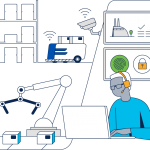Recently, I was able to spend a day with a leading food manufacturer whose products you most likely enjoyed at your Fourth of July barbecue. I was with this customer to see what they have implemented and help them understand some next steps to leverage IoT to enhance their business.
I was pleasantly surprised with the automation that this CPG customer already had in place. I was even more pleased with the fact that they use our joint Cisco and Rockwell Automation architecture as their standard for their industrial network implementation. They had just completed a new processing-to-packaging line that had over 200 different sensors aggregated up to 15 Stratix switches (Rockwell OEM products from Cisco) and then are bringing this to their operational systems for tracking and tracing.
The amount of robotics in use at this food company was pretty incredible to witness. The automation improvements were not taking away jobs but rather, adding value and new ways to up-skill line workers to take on more decision making and control of their roles in operations. Automation in this sense is moving the mundane repetitive roles away from human beings and into machines. This in itself adds tremendous value in terms of health and safety improvements. We are seeing this with not just this company but other CPG customers as well. Take a look at the CPG video below which profiles some additional automation use cases in action:
Currently their office systems are virtually separated from their operations but this will cease in the next few weeks as they are seeing benefits of tying all their operational, planning and other systems all together. This is where Cisco and our partners are bringing value—to help them understand what data they have and how this can move from data to intelligence. One key area is bringing the operational data into preventative data software to no longer “run to break down” but start to plan maintenance plans and schedules. Once we have this in place, we are going to help this company move to predictive maintenance where we take all the variables (the human resources aspects- who is available, scheduling, ordering, forecasting and more) to drive to schedule maintenance depending upon the many variables for optimization.
At the same time, we are talking about building metrics so that the various locations can be compared to start to see what can be improved at the locations from other locations to start to drive plant optimization to the next level. This includes standardizing metrics across all locations, standardizing reporting and delivery mechanisms such as our remote access capabilities and visual factory solutions. The reason they are able to do this is that they have already started to drive standardization of their networking down to the PLC layer following the Cisco and Rockwell architecture. Once this is in place, the drive towards IoT and IoE are much easier.
Others have done this across multiple industries and we are seeing this start to become implemented not just in the big companies but also the small and mid-size companies that make up the bulk of our world manufacturing economy. IoT can truly make a difference for food manufacturers, both big and small. Thanks for reading.

CONNECT WITH US